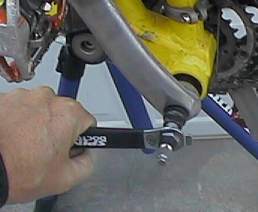|
Crank Removal and Replacement
The crankarms can be damaged where they attach to the spindle of the bottom
bracket, or where the pedal threads at the distant end. In that case, you're
going to need to get the correct replacement set before you start. Or, you may
just need to remove the chainring-side crank to replace chainrings. We'll cover
3 types of crank attachment:
Female-threaded tapered spindle - the most
common type, where a bolt holds the crank on the spindle.
Male-threaded tapered spindle - where a nut
holds the crank onto the spindle.
Splined spindle - where the spindle is a ring
with teeth that fit into slots in the crank.
Damage at the spindle (where the square hole in the crankarm fits over the
square dohickey sticking out of the bottom of your bike) is usually due a loose
retaining bolt. The crank arm slips a bit away, making the connection loose. The
spindle rotates a bit in the mounting hole and gradually deforms it.Damage at the pedal end of the crankarm occurs when crappy metal meets up
with a heavy biker slamming down on the pedal.
If you're replacing a damaged crankset, you need to buy a correct a replacement crankset. Some cranksets (for example, those designed for
eliptical chainwheels) bolt onto the chainring itself. Most attach directly to
the spindle -- the freely-rotating thing that sticks out from the bottom bracket.
If your bike has a crank attachment other than the standard female-threaded
tapered spindle, you'll want to jump to another page that covers these alternate
crank attachments.
Male-threaded tapered spindle
- where a nut holds the crank onto the spindle.
Splined spindle - where
the spindle is a ring with teeth that fit into slots in the crank, with
crank held only by the cap.
Splined tapered spindle
- often found with hollow bottom brackets, spindle has tapered teeth, requires
crank-puller.
Other crank attachments - go to the manufacturer's web
page, or do a web search
Female-threaded tapered spindle - the most
common type, where a hex-head bolt holds the crank on the spindle, which
is square with rounded edges, and has a threaded hole drilled into it.
 |
If there's a plastic protector cap, pry it off. Now remove the retaining
bolt. On most mountain bikes, this is a hex-head bolt. (On some bargain-basement
bikes, the spindle may end in a threaded bolt, with a nut holding the
crank onto the spindle. If that's what you've got, you're on the wrong
page. Click
here!)
If you loosen the bolt, then the crank falls away to show a ring with
teeth, you have a splined crank: click here!
|
| Remove the bolt from the spindle. If the crank attachment is
damaged, the crank may just fall off the spindle. In most cases, you'll need a
crank extractor tool.
DON'T remove the crank by pounding it or prying with a lever. You'll
destroy the bearings in the bottom bracket!
|

|
 |
See the treads around the inside of the crank? Thread the
big end of the crank extractor into them, as far as it will go.
|
| Now turn the core of the crank extractor in.
|

|
 |
When the core stops turning easily, it has hit the spindle.
Now it's time to apply a wrench to the core. (Most crank extractors come
with a handle specifically for that purpose.)
Continue turning until the crank has come loose from the spindle. |
| Inspect the spindle for damage, and check for side-to-side
(left-to-right) motion of the spindle in the bottom bracket.
Listen for grinding or rubbing as you turn the spindle. If the bottom
bracket is bad, now's a good time to replace it. |

|
 |
To remove the chain-side crank, put the chain around the
frame at the bottom bracket. (Note: the big disk is a "tooth
fairy" protecting the large chainring from damage.)
Now use your hex wrench and crank extractor exactly as you did on the
other side. The crank will come off with chainrings attached. |
| To remove the chainrings from the crank, unscrew the
locking. If you don't have a lockring tool, you can take off the small
chainring and remove the ring with a large pipe wrench.
If you removed the crank to replace chainrings
(rather than replacing a damaged crankset), go to work on that now.
|

|
Now place the new crank -- in the same position on the spindle as the old
one. Apply Loctite to
the threads of the retaining bolt. Tighten the bolt, and (if you have one)
replace the protector cap.
You're now ready to thread the pedal into the
crankarm.
[Fix-it Index Page]
|









